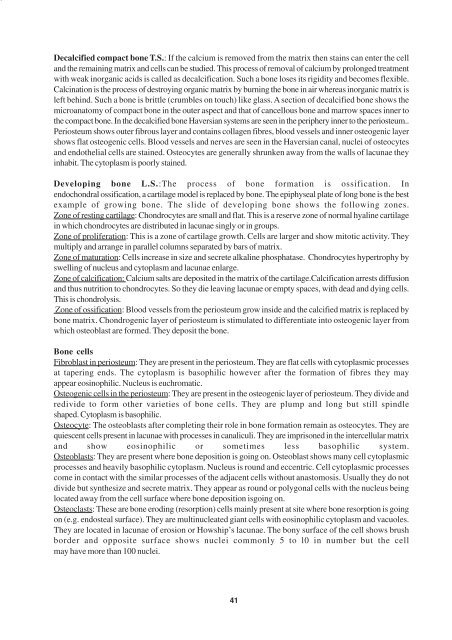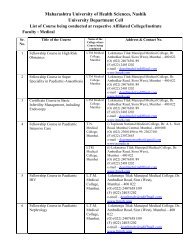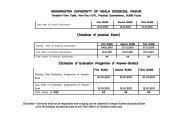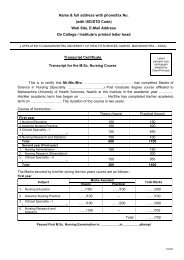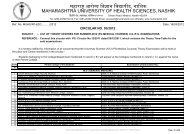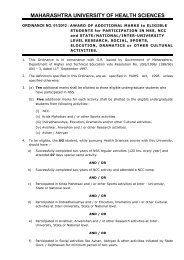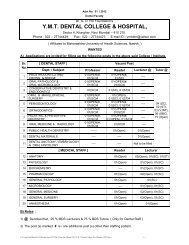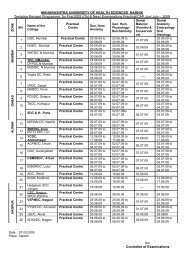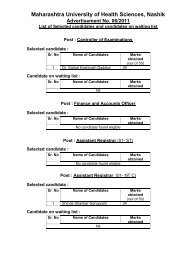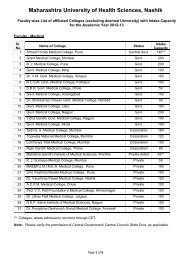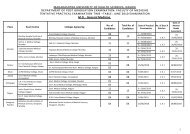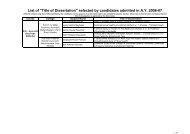Unit I
Unit I
Unit I
Create successful ePaper yourself
Turn your PDF publications into a flip-book with our unique Google optimized e-Paper software.
Decalcified compact bone T.S.: If the calcium is removed from the matrix then stains can enter the celland the remaining matrix and cells can be studied. This process of removal of calcium by prolonged treatmentwith weak inorganic acids is called as decalcification. Such a bone loses its rigidity and becomes flexible.Calcination is the process of destroying organic matrix by burning the bone in air whereas inorganic matrix isleft behind. Such a bone is brittle (crumbles on touch) like glass. A section of decalcified bone shows themicroanatomy of compact bone in the outer aspect and that of cancellous bone and marrow spaces inner tothe compact bone. In the decalcified bone Haversian systems are seen in the periphery inner to the periosteum..Periosteum shows outer fibrous layer and contains collagen fibres, blood vessels and inner osteogenic layershows flat osteogenic cells. Blood vessels and nerves are seen in the Haversian canal, nuclei of osteocytesand endothelial cells are stained. Osteocytes are generally shrunken away from the walls of lacunae theyinhabit. The cytoplasm is poorly stained.Developing bone L.S.:The process of bone formation is ossification. Inendochondral ossification, a cartilage model is replaced by bone. The epiphyseal plate of long bone is the bestexample of growing bone. The slide of developing bone shows the following zones.Zone of resting cartilage: Chondrocytes are small and flat. This is a reserve zone of normal hyaline cartilagein which chondrocytes are distributed in lacunae singly or in groups.Zone of proliferation: This is a zone of cartilage growth. Cells are larger and show mitotic activity. Theymultiply and arrange in parallel columns separated by bars of matrix.Zone of maturation: Cells increase in size and secrete alkaline phosphatase. Chondrocytes hypertrophy byswelling of nucleus and cytoplasm and lacunae enlarge.Zone of calcification: Calcium salts are deposited in the matrix of the cartilage.Calcification arrests diffusionand thus nutrition to chondrocytes. So they die leaving lacunae or empty spaces, with dead and dying cells.This is chondrolysis.Zone of ossification: Blood vessels from the periosteum grow inside and the calcified matrix is replaced bybone matrix. Chondrogenic layer of periosteum is stimulated to differentiate into osteogenic layer fromwhich osteoblast are formed. They deposit the bone.Bone cellsFibroblast in periosteum: They are present in the periosteum. They are flat cells with cytoplasmic processesat tapering ends. The cytoplasm is basophilic however after the formation of fibres they mayappear eosinophilic. Nucleus is euchromatic.Osteogenic cells in the periosteum: They are present in the osteogenic layer of periosteum. They divide andredivide to form other varieties of bone cells. They are plump and long but still spindleshaped. Cytoplasm is basophilic.Osteocyte: The osteoblasts after completing their role in bone formation remain as osteocytes. They arequiescent cells present in lacunae with processes in canaliculi. They are imprisoned in the intercellular matrixand show eosinophilic or sometimes less basophilic system.Osteoblasts: They are present where bone deposition is going on. Osteoblast shows many cell cytoplasmicprocesses and heavily basophilic cytoplasm. Nucleus is round and eccentric. Cell cytoplasmic processescome in contact with the similar processes of the adjacent cells without anastomosis. Usually they do notdivide but synthesize and secrete matrix. They appear as round or polygonal cells with the nucleus beinglocated away from the cell surface where bone deposition isgoing on.Osteoclasts: These are bone eroding (resorption) cells mainly present at site where bone resorption is goingon (e.g. endosteal surface). They are multinucleated giant cells with eosinophilic cytoplasm and vacuoles.They are located in lacunae of erosion or Howship’s lacunae. The bony surface of the cell shows brushborder and opposite surface shows nuclei commonly 5 to l0 in number but the cellmay have more than 100 nuclei.41


